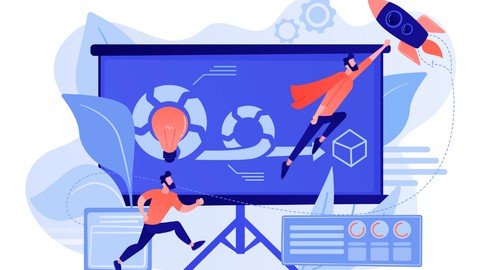
Published 6/2022
MP4 | Video: h264, 1280×720 | Audio: AAC, 44.1 KHz
Language: English | Size: 423.93 MB | Duration: 0h 54m
Agile I Scrum I PMI l Management
What you’ll learn
Everything you need to know about Agile and Scrum explained in simple language
Complete Overview of Agile Project Management
You will learn the key concepts of Agile Development, Agile Project Delivery and Agile Project Management.
You will understand the differences between Agile and traditional project delivery (other methodologies).
You will learn the meaning of user stories, daily stand-ups, retrospectives and kanban boards.
Express how heat within teams can lead to breakthrough and how to foster the right kind of heat as an agile leader
Requirements
NONE
Description
As opposed to the traditional methodologies, the agile approach has been introduced as an attempt to make software engineering flexible and efficient. With 94% of the organizations practicing agile in 2015, it has become a standard of project management. The history of agile can be traced back to 1957: at that time Bernie Dimsdale, John von Neumann, Herb Jacobs, and Gerald Weinberg were using incremental development techniques (which are now known as Agile), building software for IBM and Motorola. Although not know how to classify the approach they were practicing, they all realized clearly that it was different from the Waterfall in many ways.Aimed at “uncovering better ways of developing software”, the Manifesto clearly specifies the fundamental principles of the new approach:Through this work, we have come to agile value: Individuals and interactions over processes and tools Working software over comprehensive documentation Customer collaboration over contract negotiation Responding to change by following a planComplemented with the Twelve Principles of Agile Software, the philosophy has come to be a universal and efficient new way to manage projects. Agile methodologies take an iterative approach to software development. Unlike a straightforward linear waterfall model, agile projects consist of a number of smaller cycles – sprints. Each one of them is a project in miniature: it has a backlog and consists of design, implementation, testing and deployment stages within the pre-defined scope of work.
Overview
Section 1: Introduction
Lecture 1 Lecture 1
Lecture 2 Lecture 2
Lecture 3 Lecture 3
Lecture 4 Lecture 4
Lecture 5 Lecture 5
Anyone who wants to learn about Agile Project Management and Scrum,Leaders, managers and team members who want their teams to be more agile and resilient, even under stress and rapid change,Anyone who wants to pass the Scrum Master Certification Exam (PSM)
Homepage
https://www.udemy.com/course/agile-principles-01/
DOWNLOAD FROM RAPIDGATOR.NET
DOWNLOAD FROM NITROFLARE.COM
DOWNLOAD FROM UPLOADGIG.COM



